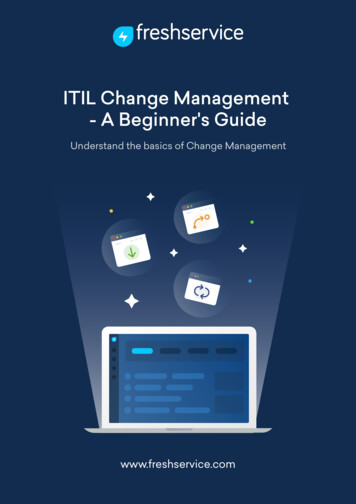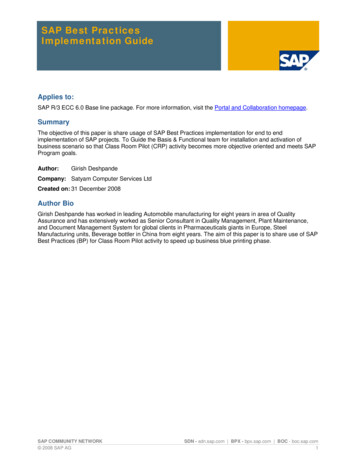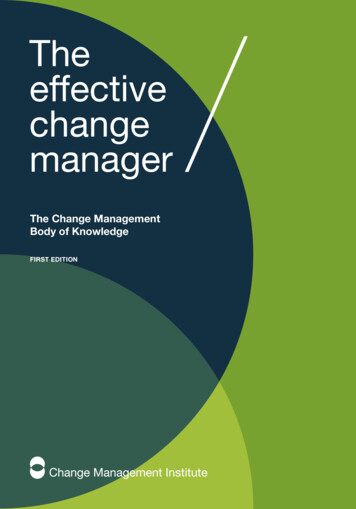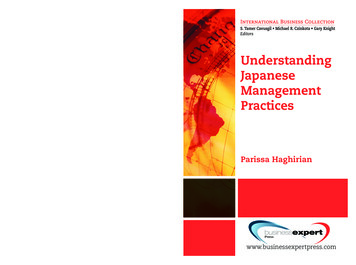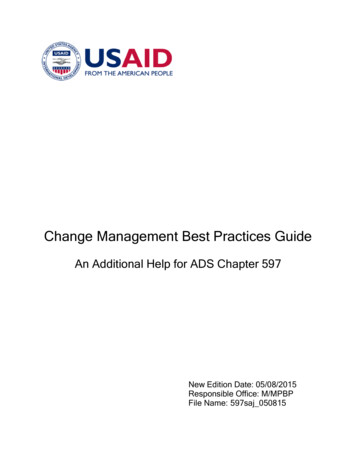
Transcription
Change Management Best Practices GuideAn Additional Help for ADS Chapter 597New Edition Date: 05/08/2015Responsible Office: M/MPBPFile Name: 597saj 050815
Change ManagementBest Practices GuidePerformance Improvement Officer
Table of Contents1.Purpose . 12.Overview . 13.Methodology. 24.Best Practices . 35.4.1Establish a Vision. 34.2Involve Senior Leadership . 34.3Develop a Change Management Plan . 44.4Engage Stakeholders . 54.5Communicate at all Levels . 64.6Create Infrastructure to Support Adoption . 74.7Measure Progress . 8Conclusion . 9Appendix A: Change Management Resources . A-1Appendix B: Methodology .B-1Appendix C: USAID Case Studies . C-1
1.PurposeThe United States Agency for International Development (USAID) has embarked on many ambitiousorganizational reform initiatives in recent years and experienced varying degrees of success withtheir implementation. A major factor impacting success is the role of change management in theprocess. Several operating units have examined the issue of change management as it pertains totheir individual initiatives. The purpose of this guide is to outline best practices and lessons learnedthat all operating units can draw upon when embarking on organizational change activities, such asimplementing new initiatives or mandates, restructuring, or introducing new technologies orpolicies.2.OverviewChange management is an organizational process aimed at helping stakeholders1 accept andembrace changes in their operating environment. It involves the application of a set of tools,processes, skills, and principles for managing the ‘people’ side of change in order to achieve thedesired outcomes of a project or initiative.USAID must incorporate the principles of change management into all organizational initiatives toproduce effective, long-lasting, and sustainable change. Over the past 20 years, researchdemonstrates that 70 percent of change efforts within organizations fail.2 A major threat tosuccessful change implementation is not focusing enough attention on the ‘people’ component ofthe change. Where success has been achieved, prominent leadership and change expert Dr. JohnKotter notes that the change process is comprised of a series of steps and requires considerabletime to produce a satisfying result.3 Ultimately, successful change management involves gettingpeople to commit to or own a change.Abundant research and data are available on how to implement long-lasting change. Appendix A inthis reference includes a few of the most prominent change management models, as well as otherchange management resources from the Federal Government and private sector. The best practicescontained in this guide synthesize major themes found across the literature and in practice atUSAID, and are found in Figure 1.1. Using these best practices in future change efforts increases thelikelihood that change takes hold and becomes engrained in the organization.1Stakeholders are those individuals, both internal and external, who have influence, impact, interest, andhave made investments in the process.2Scott Keller and Carolyn Aiken, The Inconvenient Truth About Change Management: Why it isn’t working andwhat to do about it, McKinsey and Company.3John P. Kotter, Leading Change: Why Transformation Efforts Fail, Harvard Business Review, March-April1995.1
Figure 1.1: Change Management Best PracticesEstablish a visionInvolve seniorleadershipMeasure progressCreateinfrastructure tosupport adoptionDevelop a changemanagement planCommunicate at alllevelsEngagestakeholdersLastly, it is important to highlight the issue of ‘bottom-up’ versus ‘top-down’ change. Stakeholdersare more likely to own a change if it is initiated at the working level rather than having it imposedupon them by their leadership or outside parties. However, it is not always possible or practical inthe public sector for organic change to occur, so a ‘top-down’ approach may be required. While thebest practices in this guide focus more on how to approach ‘top-down’ change, the principles arestill relevant to ‘bottom-up’ change. In fact, several of the best practices may be easier toincorporate when the push for change originates with staff.3.MethodologyTo develop a list of best practices, the Bureau for Management’s Office of Management Policy,Budget, and Performance (M/MPBP) performed desk research and conducted key informantinterviews with 20 USAID staff who were involved in initiatives that resulted in organizationalchange. These initiatives include: the Global Acquisition and Assistance System (GLAAS)deployment, the rollout of the Telework and Evaluation policies, and development andimplementation of the Bureau for Management 2003 Customer Service Standards. This guidereflects the best practices and lessons learned from the USAID case studies and external resources,as well as illustrative—though not exhaustive—examples. See Appendix B in this reference for moreinformation on the methodology used to develop the guide and Appendix C in this reference for adescription of each USAID case study.2
4.Best Practices4.1Establish a VisionChange must have a purpose with which staff identifies. Tobegin, leadership should outline the vision of the desired statethat will come about as a result of the change. The visionshould allow for shared ownership at all levels of theorganization. Staff and other stakeholders must feel connectedto the vision and understand its utility to their own work. Theymust also understand how the change personally impacts them,and acknowledge that workload or behavior change serves alarger purpose.Effective visions are: ClearUnambiguousPersonally relevantSimpleVivid4Illustrative USAID examples and lessons learned: While the Telework policy stemmed from astatutory requirement, the Telework team purposely broadened the vision of the policy to focus onenabling a more mobile workforce and changing the perception of personnel management. Thisstruck a more personal chord with USAID staff and managers, though it took some convincing.Similarly, while GLAAS is a system, the vision for its deployment was to make the acquisition andassistance process more efficient and effective in support of the Agency’s development mission. Inaddition, the GLAAS team stressed the system’s usefulness in improving reporting timeliness andquality, allowing staff more time to focus on other work. A constraining factor at USAID has beenwhen staff interprets change as a compliance exercise rather than a value-add to their work. Inother cases, staff did not understand how the change was relevant to their work. These viewpointslimit employee buy-in and adoption of the change, and operating units should take care to addressthe vision when communicating and engaging staff in the process.4.2Involve Senior LeadershipIt is critical that a coalition of senior leaders commit to and involve themselves in the design,communication, and implementation of an initiative. A study on the Agency’s efforts to promotestakeholder participation found that organizational change within USAID takes time and requiresclear and sustained leadership.5 Senior leadership should communicate that the change representsa positive development for the organization, which will lendSenior leaders need to belegitimacy to the initiative. Conversely, when leadership is notsponsors of the change, asengaged or does not view a change as a priority, staff maystakeholders tend todisregard change efforts or view the change as an activity to ‘checkrespond more positively toa box.’ A lack of leadership commitment reduces the chances ofmessaging from this group.long-run change adoption.4Communication for Governance and Accountability Program, Change Management, The World Bank, 2009.USAID, Engaging Customer Participation: USAID’s Organizational Change Experience, InternationalConference on Upscaling and Mainstreaming Participation of Primary Stakeholders: Lessons Learned andWays Forward, November 19-20, 1998.53
Illustrative USAID examples and lessons learned: The GLAAS and Telework and Evaluation policyExecutive Sponsors were prominently involved in each initiative, owning and personallychampioning the change and attending trainings. This involvement sent a strong message to staff.Development and implementation teams also leveraged Executive Sponsor participation tocommunicate effectively with the Administrator and the Agency. Though, USAID has also learnedthat when leadership attention shifts to other priorities or when the Agency tries to roll out multiplemajor initiatives at once, it compromises the incentive and ability for the organization to implementand sustain change.4.3Develop a Change Management PlanOrganizations need to develop a detailed strategy for moving from the current state to the desiredstate. USAID already exemplifies this approach through its strategic planning process outlined inAutomated Directives System Chapters 201 Planning and 597 Operations Performance Policy.The level of complexity and formality of the change management plan will depend on the nature ofthe change. To help inform the plan, an organization may conduct a change readiness assessment,which establishes the organization’s current status and ability to change. Additionally, it may alsoperform a risk analysis to determine potential risks and key barriers to change, and establish a planfor mitigation.The box to the right notes key components for achange management plan. Ultimately, the plan willhelp guide the change process and ensure steps arenot missed or efforts sidetracked. When developingthe plan, the operating unit should considerwhether to do a full implementation or roll thechange out in phases. The latter allows forincorporation of lessons learned into subsequentroll outs. The operating unit should regularly revisitthe plan to ensure they reflect the most currentthinking and any changes that occurred during theprocess. Appendix A in this reference containstoolkits that may be helpful when developing achange management plan.Change management plan keycomponents: Vision and goalsStakeholdersResourcesTime-specific milestonesCommunications tools and strategy,including key messagesMetricsRoles and responsibilitiesResults from change readiness or riskanalyses (if applicable)Finally, change management does not end once a new system or policy is rolled out. It is importantto plan for the long-run adoption of change. As such, the change management plan should cover allphases of an initiative, including post-rollout and institutionalization.Illustrative USAID examples and lessons learned: The GLAAS organizational change managementteam successfully utilized a Change Management Strategy and an Organizational ChangeManagement (OCM) Plan to guide stakeholders through GLAAS deployment. The ChangeManagement Strategy identified and validated GLAAS stakeholders, key messages, andrecommended communication tools. The OCM Plan created an actionable plan that detailed whento reach out to each GLAAS stakeholder, with what information, using what messages, and withwhich communication tools.4
Similarly, the Telework team employed project management techniques to keep everyone focusedon the same goals and tasks. These techniques included: creating an executive board, defining clearphases of execution, setting deadlines, establishing subteams to focus on trainings andcommunication, and assigning clear accountability for tasks.USAID has learned that the absence of a comprehensive implementation plan can lead tomisunderstandings about the initiative across the organization and the Agency reacting to issues inan ad hoc versus deliberate manner. Given the decentralized nature of USAID, well-developed planscan reduce the risk that initiatives are unevenly or partially adopted. USAID has also learned thatchange management takes time. Many initiatives are multi-phase processes, where the Agency willnot realize full adoption for many years. Therefore, it’s important to plan for how a change willmature over time.4.4Engage StakeholdersPeople are at the core of any successful change.6 Involving stakeholders early, often, and in ameaningful way “helps reduce barriers to change by creating psychological ownership, promotingthe dissemination of critical information, and encouraging employee feedback for fine-tuning thechange during implementation.”7 A Booz Allen Hamilton study of governmental change effortsfound that 75 percent of successful change leaders utilized a collaborative approach for developingand implementing change, compared with 33 percent of unsuccessful change leaders.8Operating units should use a stakeholder analysis to identify theindividuals and groups that the change impacts and understandtheir positions regarding the change. A stakeholder analysis isparticularly beneficial for USAID change efforts given the varietyof staff and stakeholders associated with the Agency. Twocategories of stakeholders are particularly important: changeChange resistors champions (also known as change agents) and resistors ofindividuals who opposechange. Individuals in both categories may come from all levelschange and may try toof the organization. Change champions are invaluable inprevent its implementationpromoting and legitimizing an initiative and establishing a groupof subject matter experts to supplement those on the development and implementing team. Theycan help drive the change from the bottom up.Change champions individuals who aresupportive of change andeager to see it implementedConversely, those that resist change may do so for a variety of reasons, including being fearful ofsomething new or protective of the status quo. Proactively and sincerely engaging resistorsprovides them with an opportunity to express concerns, which the organization can address, to theextent possible, during implementation. It is important to not ignore those that resist change6Suzanne Bond Hinsz, Change Management, Deloitte, USAID Presentation, March 2013.Sergio Fernandez and Hal G. Rainey, Managing Successful Organizational Change in the Public Sector, PublicAdministration Review, March/April 2006.8Dave Mader, Steven Kelman, and Jeff Myers, What It Takes to Change Government: Successfully ExecutingAmbitious Strategies, Booz Allen Hamilton.75
because they can wield a great deal of influence among other stakeholders. In all cases, stakeholderparticipation should be widespread and pervasive during the different stages of the change effort.9Engaging stakeholders can also include incentivizing them to produce the desired behavior. Staffand manager position descriptions, annual work plans, and evaluations must reflect post-changeactivities and expectations. Besides annual evaluations, monetary and nonmonetary awards andrecognition can assist in promoting desired actions.Illustrative USAID examples and lessons learned: The working group that developed the Bureau forManagement 2003 Customer Service Standards included representatives from across stakeholderbureaus. The Evaluation and Telework policies and GLAAS deployment also relied, and continue torely, heavily on points-of-contact and subject matter experts in each bureau, independent office,and mission to disseminate key information and implement specific provisions of the initiatives.Early on, the working group that developed the Telework policy included some who opposed thechange. Embracing and addressing staff and managers’ concerns upfront helped mitigateroadblocks during later stages of implementation and encouraged ownership. In all the cases,engaging stakeholders proved critical to moving the change forward.It may not be possible for USAID to engage all possible stakeholders in a given change, but operatingunits should make reasonable attempts to be inclusive. USAID has also learned from its struggle torealize sustainable change when not holding staff accountable for implementing new initiatives. Insome cases, operating units did not include standards reflecting the post-change environment instaff annual work plans. Without this incentive, it was more challenging for the Agency to elicit thedesired behavior.4.5Communicate at all LevelsCommunication is one of the most important elements to a successful change effort—it sets a toneof transparency and openness. Proper communication can serve a myriad of functions, including: Communication should:Conveying the vision, goals, and motivation for change;Sharing information about organizational changes and Occur repeatedly andproviding stakeholders with details about the nature,through multipletiming, and significance of the change;channelsEliciting participation and specific actions from Include opportunity forstakeholders;questions and feedbackProviding social support by addressing concerns, Be tailored to specificalleviating fears, and encouraging support systemsrecipientsamong employees; andProviding feedback to employees about theirperformance during change initiatives and providing feedback to implementers regardingstrengths and weaknesses of the change initiative.109Sergio Fernandez and Hal G. Rainey, Managing Successful Organizational Change in the Public Sector, PublicAdministration Review, March/April 2006.10Communication for Governance and Accountability Program, Change Management, The World Bank, 2009.6
Consistent communication is important to preserve and reinforce key messages, which should relateback to the higher-level objectives and vision for the change. Senior leaders and change championsshould serve as communicators to enforce these key messages. Further, organizations can use inperson communication, where feasible, to establish relationships with stakeholders.Communication is also an effective method for helping people overcome their resistance tochange.11Illustrative USAID examples and lessons learned: USAID has experienced the greatest impact whencommunication occurs through varied internal and external mechanisms. For example, the Agencyhas utilized Agency Notices, emails, websites, reports, presentations, in-person meetings, trainings,and informal discussions to effectively get the word out to both Washington and the field. TheGLAAS and Telework teams employed communication protocols that matched the message senderwith the message purpose to maximize impact and promote timely communication. The GLAASimplementation team also sent out communications well in advance of the deployment of thesystem to let stakeholders know a change was coming. Communication continued well after therelease of GLAAS to proactively ask users if they needed help or assistance.USAID has learned that it is necessary to offer stakeholders current and logically organizedinformation to maximize the communication’s utilization and value. The communication must be informats to which stakeholders pay attention and using messages to which stakeholders relate,otherwise it will not register with them. USAID has also not been as successful when senior leadershad limited involvement in disseminating key messages to operating units.4.6Create Infrastructure to Support AdoptionAltering organizational norms, behaviors, and culture is one of the most difficult aspects of changemanagement, but is also one of the most important. The process takes considerable time—severalinitiatives that USAID has officially launched in recent years are only in the beginning stages ofinstitutionalization. For these reasons, senior leadership and operating units must work together tocreate an environment and provide the tools necessary to promote long-run adoption.Training is critical for familiarizing stakeholders with the details of change and how it applies to theirwork. Through training, staff gains a concrete understanding of how his/her behavior needs tochange, the ultimate benefits the organization will realize, and theReinforce change throughskills needed to effectively institute the change. Given the diversityorganizational structures:of talent at USAID, organizational change efforts may require asignificant investment in training of both staff and partners. Policies ProceduresSenior leaders also need to consider their ability to dedicate and Systemsmaintain resources for a change over the long term. This includesadequate staff, space, equipment, and funding. The provision ofresources signals to stakeholders that the change is a priority and the organization is laying thefoundation for success. Failure to allocate sufficient resources can prevent sustainable change.1211John P. Kotter and Leonard A. Schlesinger, Choosing Strategies for Change, Harvard Business Review, July2008.12USAID, Synthesis Report for USAID/AFR Change Management Assessment, March 15, 2013, page 78.7
Senior leadership should also consider their ability to utilize change management-specific resources.External consultants or internal staff with expertise can help ensure operating units incorporatechange management principles into the planning and implementation of an initiative.Illustrative USAID examples and lessons learned: As part of the release of the Evaluation policy, theBureau for Policy, Planning and Learning established trainings to rebuild USAID staff capacity andcontinue to offer training today. Similarly, the Agency institutionalized the Telework policy bymaking telework training mandatory for all USAID staff at every level. While USAID was not requiredto conduct the training in-person, the Telework team believed they would be more effective inreaching staff in a face-to-face environment. The GLAAS and Telework teams also found itimportant to have staff with the right skill set as trainers to lend credibility to the trainings and makethem enjoyable for attendees.USAID has successfully utilized work groups or teams to develop and implement change. Initiatives,supported with dedicated human resources post-implementation, are on track to experience longlasting adoption. However, USAID has also learned that when the resource allocation does notmatch the level of effort required to institutionalize a change, progress can slow or halt. USAID doesnot have dedicated staff with experience in change management. Individual initiatives rely onoutside assistance or staff with a background in project or change management, but there is nocentral resource for operating units to tap into for expertise and guidance. Identification of aresource would be valuable to the Agency.The Agency has also learned that a lack of official guidance codified through policies and proceduresduring early stages of implementation can leave the door open for interpretation. Making thesetools available in a timely manner can help ensure consistency, increase compliance, and reduce therisk of contradictory information coming out later in the process.4.7Measure ProgressOrganizations need metrics to measure progress and change. Who will collect andMeasurement and reporting allows operating units to understandanalyze the data?if stakeholders have implemented the change as intended, and How and when aremake course corrections where needed. Evaluation anddata collected?monitoring must continue post-implementation to ensure the What will organizationorganization does not lapse into old behavior.13 Early in thedo with the results?planning process, operating units should identify metrics that willappropriately demonstrate adoption of the desired change.Publicizing the results throughout the organization can help institutionalize change and reaffirmmessaging on its ultimate purpose.Illustrative USAID examples and lessons learned: To demonstrate its evolving implementation,USAID tracks employee participation in and satisfaction with telework through the FederalEmployee Viewpoint Survey and the Agency’s time and attendance system. Similarly, the GLAAS13Sergio Fernandez and Hal G. Rainey, Managing Successful Organizational Change in the Public Sector, PublicAdministration Review, March/April 2006.8
team monitors Helpdesk inquiries to identify areas where additional guidance is needed to improveutilization.Yet, USAID has also learned from its experiences with inadequately planning for monitoring andassessing change. The lack of a tracking system and follow-up on metrics limits accountability andcan contribute to a perceived absence of long-term change. In addition, USAID struggled with theimpact stretch targets not grounded in evidence can have on a new initiative. While establishingtargets is important to focus and motivate the organization around a change, the Agency must settargets in a manner that aligns with institutional capacity and supports the goals of the change.5.ConclusionUSAID operates in a dynamic, constantly changing environment. As part of effective organizationalmanagement, it is important for operating units to have the tools necessary to react to andimplement change successfully. While it requires an initial outlay of time and resources,incorporating change management best practices into the design and implementation of newactivities supports the institutionalization of long-lasting change.9
Appendix A: Change Management Resources1.Change Management ModelsOrganizational change management literature is rich with models and philosophies of change. Thefollowing is a summary of three well-known change management models.Dr. John Kotter’s Eight Step Process for Leading ChangeBased on his study of hundreds of private sector organizational change efforts, Harvard professor Dr.John Kotter categorized successful change into eight basic steps (Figure A.1). In 1995, in previewing hisnow widely-cited book, Leading Change, Dr. Kotter wrote, “The most general lesson to be learned fromthe more successful cases [of corporate change efforts] is that the change process goes through a seriesof phases that, in total, usually require a considerable length of time. Skipping steps creates only theillusion of speed and never produces a satisfying result.”14 More information on the eight-step processcan be found at Kotter International.Figure A.1: Kotter’s Eight Step Process151415John P. Kotter, Leading Change: Why Transformation Efforts Fail, Harvard Business Review, Spring 1995.Suzanne Bond Hinsz, Deloitte Consulting, Change Management, USAID In-House Presentation, March 2013.A-1
Kurt Lewin’s Three-Step Approach to Planned ChangeIn the 1940s, Kurt Lewin, a social psychologist, proposed a three-stage approach to planned changeinvolving unfreezing, changing, and freezing. The model is still recognized today for its relevancy inmodern change management. The three stages are described below.161) Unfreezing: This stage is about getting ready to change. It involves getting to a point ofunderstanding that change is necessary and getting ready to move away from our current comfort zone.This first stage is about preparing people before the change (and ideally creating a situation in whichpeople want the change). This first 'Unfreezing' stage involves moving individuals, a department, or anentire business, toward motivation for change.2) Changing: Change is not an event, but rather a process. Lewin called this process a transition.Transition is the inner movement or journey individuals or a company/organization makes in reaction toa change. This second stage occurs as needed changes are made. This stage is often the hardestbecause people are unsure or even fearful. They are learning about the changes and need to be giventime to understand and work with them. Support is very important at this stage, which can be in theform of training, coaching, and expecting mistakes as part of the process. It is also useful to keepcommunicating a clear picture of the desired change, and the benefits, so people do not lose sight of thevision.3) Freezing: This stage is about establishing stability once changes have been made. As the changes areaccepted and become the new norm, people form new relationships and become comfortable with theirroutines. It can take time to anchor changes into a culture and prevent backsliding into previousbehavior.16Mark Connelly, Kurt Lewin Change Management Model.A-2
Awareness, Desire, Knowledge, Ability, Reinforcement (ADKAR) ModelThe ADKAR model was first introduced b
change management plan. Finally, change management does not end once a new system or policy is rolled out. It is important to plan for the long-run adoption of change. As such, the change management plan should cover all phases of an ini



